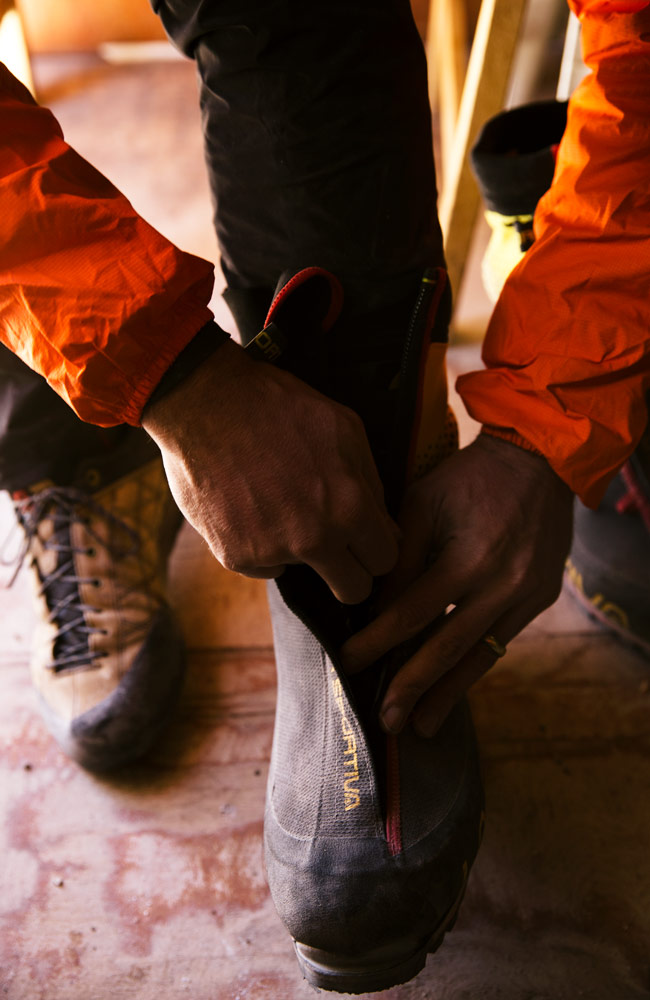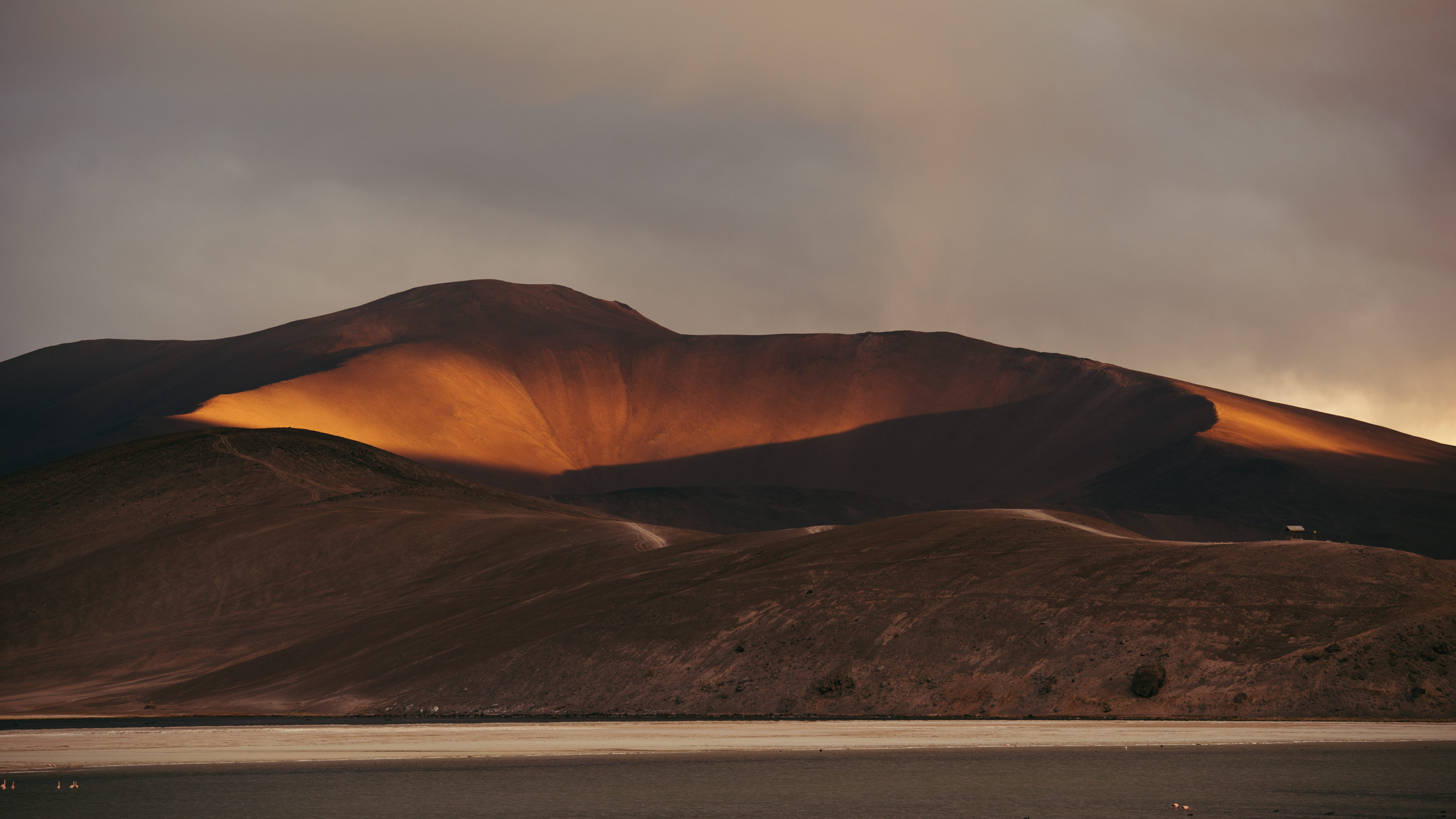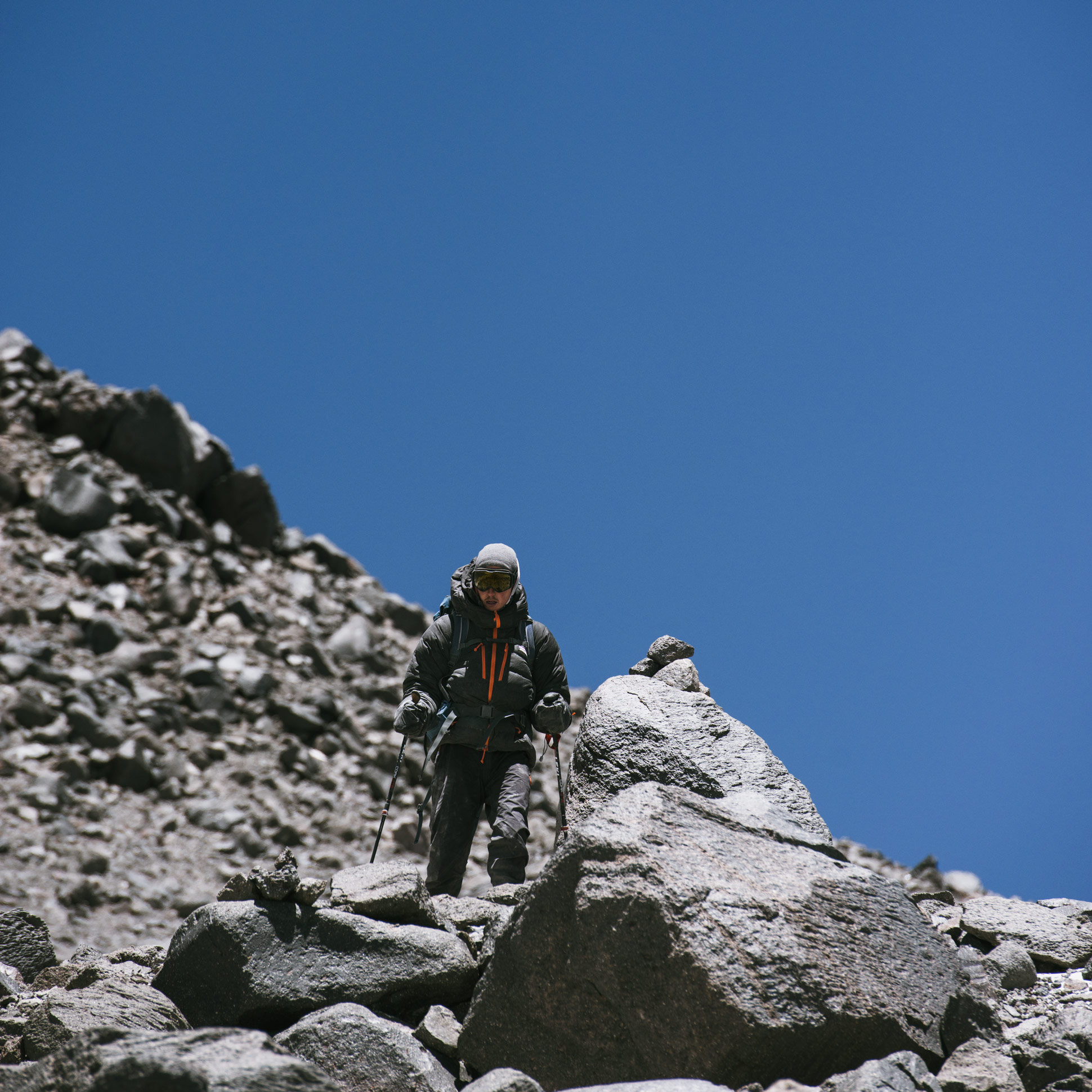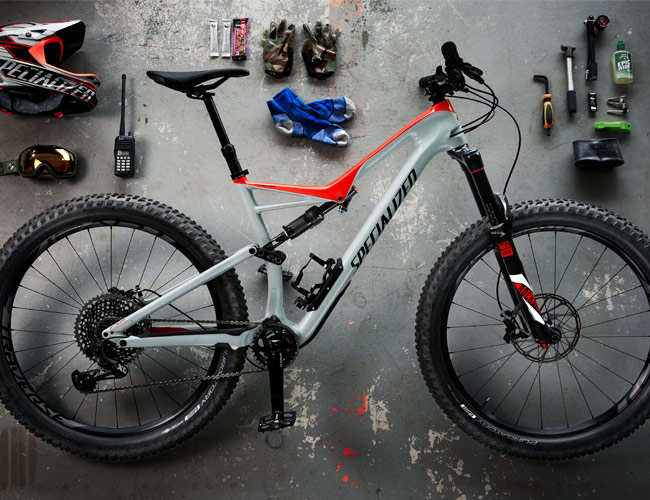E
ach day, for the next seven days, we spent a few hours exercising at altitude. All of us but Rob (“I’m not trying to be a tough guy,” he told me, “I just want to see what I’m made of”) had begun taking the altitude-easing drug Diamox to fend off malaise. One day, we untethered our bikes, grabbed our face masks and skidded down some trail and scree above the lake. Another afternoon, we climbed to 16,000 feet on a neighboring peak, accessed via some white-knuckle, Mad Max off-roading in heavy wind. It was hard to imagine climbing 6,500 feet higher, but the pale eyes of Ojos, visible in the distance, had a come-hither look.
After two nights in single-degree weather, we drove on to our next camp: 14,200-foot Laguna Verde, past the ancient frozen carcass of a wayward cow, where a “thermal bath” was advertised. On the way to the tepid waters, tucked inside a small wooden refuge, we passed by a contingent of Russian visitors permanently playing cards in the shelter’s main room, drinking vodka and fondling their expensive satellite phones. On Thanksgiving, we took turns expensively calling home with our own, allowing two minutes each for the impossible task of describing the bioluminescent night sky. It was fantastically lousy with astral matter.
Life at fourteen thousand feet is simple but hard. You must move slower, take more breath, think harder.
Laguna Verde is where Justin started acting funny. Though a strong cyclist — he’d kicked my ass on a ride in Georgia, a week earlier — he had the least high-altitude experience. It began to show when he tripped down stairs, repeatedly misnamed a refuge, and became uncharacteristically sluggish, even tongue-tied. After a day hike, he fell asleep in the truck with his headlamp on, glacier goggles in place. (These made him resemble an alpine Ray Charles.) Once roused, he refused dinner, blaming Diamox. That night he got a nosebleed, which persisted, on and off, for days, producing Rorschach-like red blots on our precious toilet paper.

Life at 14,000 feet is simple but hard. You must move slower, take more breath, think harder. At this elevation, there’s only 60 percent of the oxygen found at sea level; at 22,600 feet, it’s 40 percent. The high desert amplifies the sense of distortion. There are no trees, of course. Only monochromatic sand and rock. Meat-locker cold and constant wind. The occasional mirage. A circling, hungry-looking bird. But most of all: these huge mountains, decorated with strange penitentes: clusters of icy spires sticking straight out of the ground towards the sun. An absurd arctic art project, by the Great Unseen Hipster Artist in the Sky.
Hernan and Fabaola were our psychic anchors, but they would leave us soon. Another guide, named Mario, would take their place for the summit push, once we’d relocated again, negotiating a labyrinth of deep sand ruts and rock garden travel in our Hilux, to a cozy, climber-graffitied shelter at 17,000 feet: a repurposed, abandoned Russian shipping container, it turned out, that had housed a massive telescope high on Ojos in the early ’80s. It completed our miniaturization.
Mario, we gathered, was el hombre. He slept in a duct-taped sleeping bag. He barely needed water, like a high-altitude camel. He’d been atop Ojos 56 times and still had all his fingers and toes. He’d guided three German climbers to just below the summit earlier that week, in fact. They’d turned around with one hundred meters to go, after nine hours. It was too windy, too cold. One of them had developed a hypothermic finger. Whether amputation would be necessary was still unknown.
Blood began to flee my patchily bearded face for my toes.
T
here was some good news: the weather was supposed to improve, slightly, during our narrow summit window at the end of November. Winds would slow from 60 mph to perhaps half that. Temperatures might inch up towards zero degrees. This, during the start of summer on Ojos, would be mild. Drinking his second mug of black coffee at Atacama Refuge, on our final day of rest, Rob was ebullient. “I could live up here,” he announced during a brief lull in the wind.
A Russian duo had read the same optimistic weather report, apparently. They appeared a day later at the final refuge, Tejos, where we’d ‘rest’ at 19,150 feet — sound sleep is a futile wish so high up — the night before our 4 a.m. summit attempt. We’d passed them on the 2.4-mile, two thousand vertical path up to Tejos, pushing our bikes through the volcanic ash like a band of Sisyphean cyclists condemned to usher their machines up volcanoes for eternity.
Apart from some strange facial tingling, I felt okay. Rob’s headaches persisted, but he didn’t complain. (“Messner wouldn’t bitch!”)
The short, mustachioed, fiftyish guide, Victor Bobok, had climbed each of the earth’s seven summits twice, including Mt. Everest three times. His lone client was younger, larger, wealthy-looking and, judging by his lethargic trudge, a dilettante mountaineer. They ate expensive cheese and generally ignored us after announcing their intention to leave the refuge at one in the morning, for an alpine start.
Justin and Doug were on the fence about going for la cumbre. Though his look and talk had improved, it seemed inadvisable for Justin, particularly, to proceed to the top, much as we wished to remain a team. Doug’s portable pulse oximeter, which measures oxygen saturation in the blood, confirmed the obvious: Justin was still struggling to acclimatize. Only Chris, Rob and I seemed to be in the healthy blood-oxygen range for this altitude. Apart from some strange facial tingling, I felt okay. Rob’s headaches persisted, but he didn’t complain. (“Messner wouldn’t bitch!”) In fact, he began to actually drool the closer we got. The hungry kind of drool.
Maybe my brother, unlike most humans, did belong up here.

A
fter nodding off around nine, I woke to piss, again, at 11:45 and mostly rolled around for the next four hours, listening to gaseous bugle calls from neighboring bunks until alarms blared mercifully. It was -25 degrees and windy when I stepped outside a little after four in the morning. We’d made coffee, eaten a few muffins, put snacks and water in our lightened packs and layered up. We wore two pairs of socks inside our La Sportiva super-gaiter boots.
Few words were exchanged, beyond the necessary:
Three liters of water?
Gloves or heavy-duty mittens?
These fucking bikes…
We’re not bringing the beer.
Only 15 percent of climbers (without bicycles) reach the summit, totaling some 250 a year. Doug had finally informed us of this statistic — which has everything to do with extreme elevation, cold and windy weather and the easiness of underestimating the mountain, as opposed to any truly technical features — a few days earlier. By then, we were no longer surprised. A strong, Alps-experienced solo climber from Germany — he referred to himself, earnestly, as a “climbing machine” — had gone up just the day before with some muesli, an apple and hot tea and come down defeated, his nose purple, his face lined with extra years. It might be a “walk-up,” but it was not “easy,” except, perhaps, compared to Denali or K2 or Meru.
“I don’t know,” the climbing machine murmured as we offered him hot water. “I just did not have the energy on this day. Maybe if I had not lost the route… ”
W
e pushed our bikes up the ashy, steep and windswept slope of the volcano to about 20,000 feet, more than half a commercial airplane’s cruising altitude. At this point, the unstable trail — such as there was one — angled up more acutely, to perhaps 40 degrees. Riding down this, even at sea level, would be absurd. So we dropped the bikes after a terse powwow — channeling Ahab, I wanted to keep pushing them, while Rob correctly but annoyingly advised against this — and continued behind Mario. A five-some distinguished by small beams of light and labored breathing, we’d begun the morning with 1.8 miles to the summit and 3,600 feet of elevation to gain. The average one-way trip from Tejos took eight hours.
Within 20 minutes, Justin and Doug had fallen far behind. I couldn’t see them. Mario warned us, matter-of-factly, that their pace was too slow. There was no time, energy or authority to question his opinion.
“I can’t go on. Gotta go back. Could get frostbite. People get frostbite up here, right?” Mario nodded.
The message was conveyed and, though frustrated, they dutifully retreated. Fifteen minutes later, Rob complained that his toes were numbing. We stopped, unable to escape the wind, and shouted about our shitty options: to mush on into the colder regions above or turn around. I pulled out foot-warming pads and extra socks. The latter wouldn’t fit in Rob’s boots. The former would take a while to heat up, and his feet were worsening. He removed a boot and rubbed the colder foot. Chris swaddled it in an extra down layer. Nothing.
“FUCK!” Rob yelled, in a foreign tone. He’s not the complaining, compromising, stop-just-to-be-safe brother. He barrels headlong into the overhead surf, the waist-deep snow, the hostile crowds, as I shout, from some remote bunker behind him, to pump the brakes. So his words made no sense.
“I can’t go on,” said Rob. “Gotta go back. Could get frostbite. People get frostbite up here, right?” Mario nodded. I was scared for Rob and, suddenly, myself. His confidence, to this point, had buoyed my modest self-belief. Could I continue? Should I continue? To be safe, Mario escorted Rob back to the now invisible hut, in the dark, where he would prop up his feet next to a camp stove and try to banish thoughts of Messner (who has only three toes left) and what he’d do in the same situation. Meanwhile, Chris and I danced in place on the upper flank of the volcano, a pair of freezer-burned marionettes. This whole trip had been the product of our fertile imaginations, and now we faced the frigid, sober reality of the thing. The FUCK of it.
My right foot felt a little funny, too.

Ten minutes after Mario returned, Chris, in turn, headed down. There was less protest in him. His toes, too, were burning cold and, as both a young father and a necessarily pragmatic diabetic, he accepted the meaning. Mario, meanwhile, had made clear that things would worsen before they might ever improve: “Sol,” he said, “maybe three hours. Wind and cold, more bad.” He gestured up into the bleak, bleary-eyed black-and-whiteness of the mountain above.
“You got this,” Chris told me, as he disappeared. I thought briefly of Krakauer, who’d also been on assignment on Everest in ‘96. Had fear of failing before his readers helped him reach the top and get back down without dying? Or was he just a tough sonuvabitch with good circulation and better boots?
The comparison, in any case, was a far reach. What propelled another man didn’t matter as I found myself trudging upward, in the godless cold, behind only Mario. He kicked his boots into the volcanic debris to gain purchase. I did the same. The rhythm was regular, nearly calming. This pattern repeated itself for distended hours, my mind hanging on to its default survivalist mantras (“One step at a time”; “When you feel finished, you’ve still got fifty percent left”), my toes retaining just enough heat. Gradually, the Andean valley appeared in the twilight. I greeted it with a barrage of disdainful snot-rockets that seemed to freeze mid-air.
“Sol!” Sol! I echoed Mario’s plaintive call. This was our main exchange.
J
ust before the first rays arrived — to better reveal, if not alleviate, our suffering — I felt a disconcerting sensation: freezing at the tip of my dick. First I rubbed it with a mittened hand. Then I yelled ahead to Mario. Using fria and crude sign language, I tried to convey what seemed to be happening. Mario nodded and kept walking. Finally, I took the extra wool socks out of my pack — the ones I’d offered to Rob before he turned around — and used them to insulate the sad, frozen worm. My future children will thank me one day for this, I thought.
After four and a half hours of steep switchbacks, Tejos disappeared behind a ridge. The bright blue speck of Laguna Verde still showed farther beyond. Through my goggles, pieced together by an oxygen-depleted brain, the Andes looked like so many overwrought sandcastles. I unscrewed a water bottle, knocked out a fresh rim of ice, and swallowed as much as I could before the freeze set in.
“One more hour?” I said, wishfully, to Mario.
“One to caldera,” he replied. “One more to cumbre.”
Want to follow in the author’s footsteps? (You sure?) Start here. Read the Story
The buff covering my face had half-frozen around my mouth. A rope of mucus hung from my raw nose. But I was getting somewhere, and beginning to have a foretaste of glory. Forty-five minutes later, the snow-covered edge of the volcano’s caldera appeared: a depression resulting from a long-ago eruption, looking much like a lake in dead winter. A few hundred yards around it, lurching towards the top like lost, seasick fishermen, were the Russians. We’d made up their three-hour lead. I felt a competitive burst of energy. Where had it been stored as I staggered along these past few hours? I saved a thought for later: The human body — to say nothing of the mind — is strange even to itself. Walking above 20,000 feet reminds one of this.
We met them just below the 200-meter climb up to the summit. It was a steep, narrow, bouldered section, one that most mountaineers use fixed ropes to ascend. Conceding our faster pace, they moved aside — for Victor, who could have summited twice by now, the deference seemed begrudging. I pulled myself onto the small summit block minutes later, teeth chattering uncontrollably. How long has that been happening? I glanced at my watch: It was 10:30 in the morning, the hour I usually get down to work, coffee in hand, dog lying at my feet…





